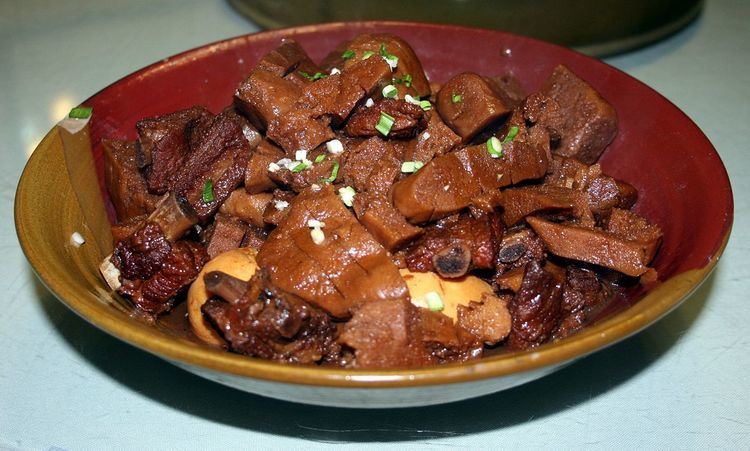 | ||
Shandong cuisine (simplified Chinese: 山东菜; traditional Chinese: 山東菜; pinyin: Shāndōng cài), more commonly known in Chinese as Lu cuisine (simplified Chinese: 鲁菜; traditional Chinese: 魯菜; pinyin: lǔ cài), is one of the Eight Culinary Traditions of Chinese cuisine and one of the Four Great Traditions (四大菜系). It is derived from the native cooking style of Shandong, a northern coastal province of China.
Contents
Features
Shandong cuisine is famous for its wide selection of material and use of different cooking methods. The raw materials are mainly domestic animals and birds, seafood and vegetables. The masterly cooking techniques include Bao爆 (quick frying), Liu溜 (quick frying with corn flour), Pa扒 (stewing), roasting(烤), boiling(煮), using sugar to make fruit, crystallizing with honey.
Styles
It's commonly known that Shandong cuisine is divided into two styles, Jinan and Jiaodong. The style of Shandong cuisine are known for its light aroma, freshness and rich taste. It puts emphasis on its two types of broths, light and milky. Both broths are seasoned with scallions and goes well with the freshness of seafood.
Influence
Although less available in overseas Chinese restaurants (usually operated by migrants from southern China), Shandong cuisine is considered one of the most influential schools in Chinese cuisine; most of the country's culinary styles have developed from it. Modern cuisines in North China (Beijing, Tianjin and the northeastern regions) are branches of Shandong cuisine, and meals in most Northern Chinese households are typically prepared using simplified Shandong methods.
During the Spring and Autumn period (770-221 BC), Shandong was a territory of Qi and Lu. Both states, with mountains and fertile plains, were economically and culturally developed and had abundant aquatic products, grains and sea salt. Some of the earliest known descriptions of Chinese culinary methods come from the states. Yi Ya, a retainer of Duke Huan of Qi, was renowned for his culinary skill. Confucius (who was born in Lu) was quoted in the Analects as saying, "One should not indulge overly in fine flour, or in kuai (a dish akin to carpaccio) that is sliced too thinly". About food, he recommended: "Do not consume food which looks spoiled, smells spoiled, is out of season, is improperly butchered, or is not made with its proper seasoning"; this indicated a level of refinement in food preparation in Shandong at the time.
The cuisine as it is known today was created during the Yuan Dynasty. It gradually spread to northern and northeastern China, Beijing, Tianjin, and the emperor's palace, where it influenced imperial food. Shandong cuisine is primarily made up of eastern Shandong and Jinan dishes.
Ingredients
Although modern transportation has increased the availability of ingredients China, Shandong cuisine remains rooted in tradition. It is noted for its variety of seafood, including scallops, prawns, clams, sea cucumbers, and squid.
Maize
In addition to seafood, Shandong is unique for its use of maize, a local cash crop not widely cultivated in northern China. Unlike the sweet corn of North America, Shandong maize is chewy, starchy and often has a grassy aroma. It is served as steamed (or boiled) cobs, or the kernels are removed from the cob and lightly fried.
Peanuts
Shandong is noted for its peanuts, which are fragrant and naturally sweet. Large dishes of peanuts (roasted in the shell or shelled and stir-fried with salt) are common at meals, and they are served raw in a number of cold dishes from the region.
Grains
Shandong uses a variety of small grains. Millet, wheat, oats and barley can be found in the local diet, often eaten as congee or milled and cooked into a variety of steamed and fried breads. People in Shandong tend to prefer steamed breads rather than rice as a staple food.
Staple vegetables
Despite its agricultural output, Shandong has not traditionally used the variety of vegetables seen in southern Chinese cooking. Potatoes, tomatoes, cabbages, mushrooms, onions, garlic and eggplant are staple vegetables, with grassy greens, sea grasses and bell peppers also common. The large, sweet cabbages grown in central Shandong are known for their delicate flavor and hardiness; a staple of the winter diet in much of the province, they appear in many dishes.
Vinegar
Shandong's greatest contribution to Chinese cuisine is arguably its vinegar. Hundreds of years of experience and unique local methods have led to the region's prominence in Chinese vinegar production. Unlike the lighter, sharper vinegars popular in the south, Shandong vinegar has a complexity which some consider fine enough to stand alone.
Jinan Cuisine (济南菜)
The cooking methods of Jinan Cuisine are focused on quick frying (爆), roasting (烤), and boiling (炸). Jinan-style food is generally sweet, aromatic, fresh, and tender. A famous dish from Jinan is Tangcu dahuangyu (糖醋大黄鱼), stir-fried fish with sugar and vinegar.
Jiaodong Cuisine(胶东菜)
Jiaodong Cuisine is more focused on cooking and cutting skills. The Jiaodong area is located close to the sea, so most raw materials are seafood. Sea cucumber, abalone, and scallop are common in this area. A famous Jiaodong-style dish is Congshao haishen (葱烧海参), which is stir-fried sea cucumber with green onion.
Kongfu Cuisine(孔府菜)
The family of Kong is the descendant of Confucius (孔子). The family of Kong was the largest family in Chinese history, lasting about 2000 years. The family of Kong always got rewards from the emperor, so the family of Kong had high standards for the quality of every dish. This is the reason why all Kongfu dishes look beautiful, and are prepared with excellent cutting skills.
Luxinan Cuisine(鲁西南)
Luxinan is the area southwest of Shandong province. People living in this area like to eat health food with Chinese medicines and raw materials.
